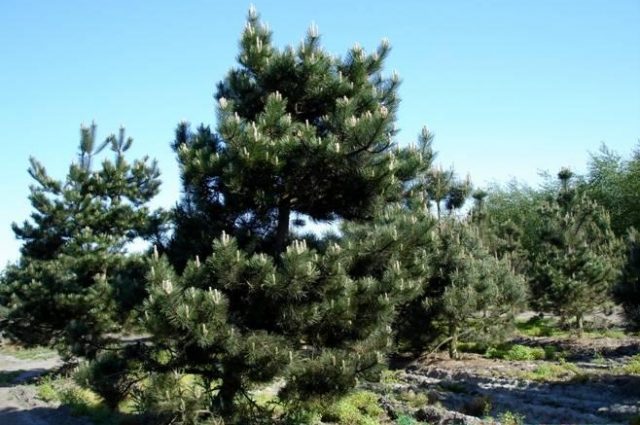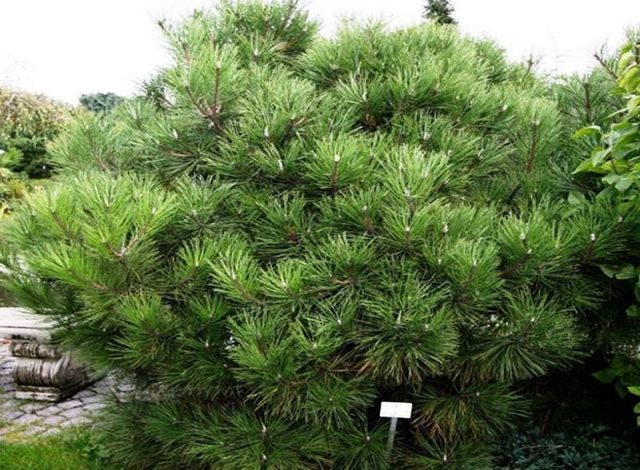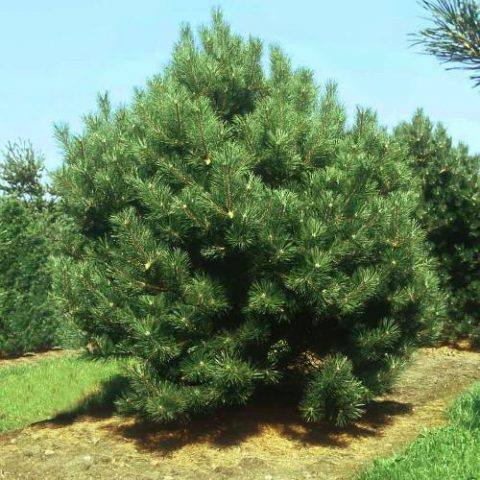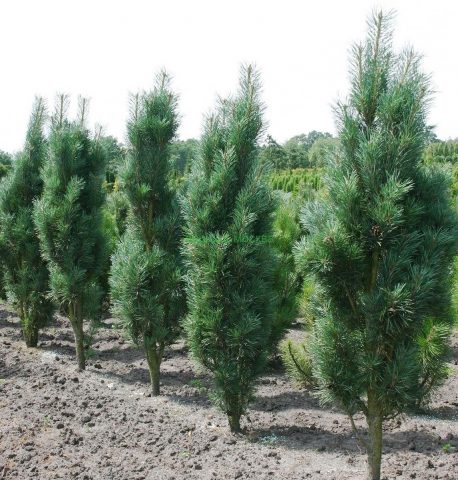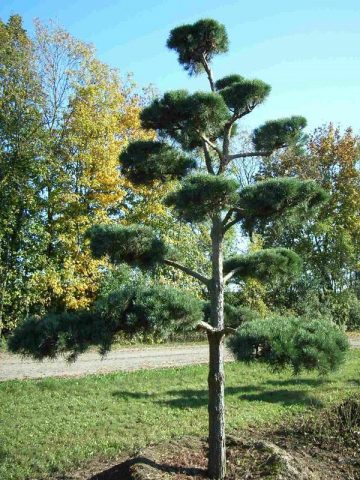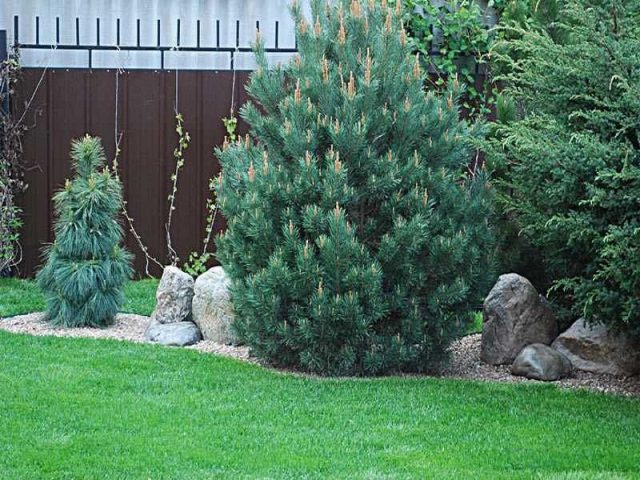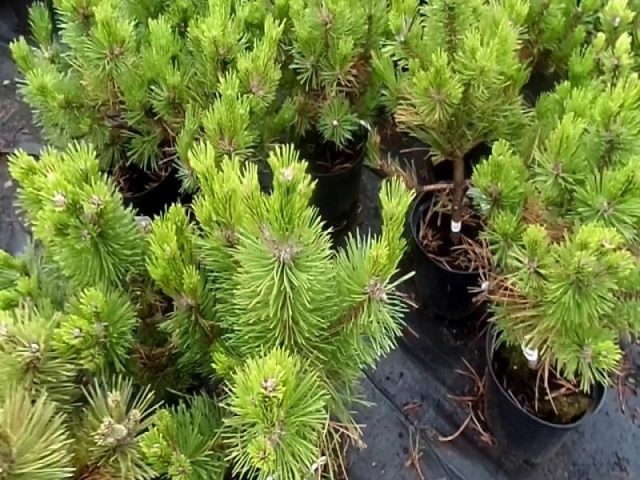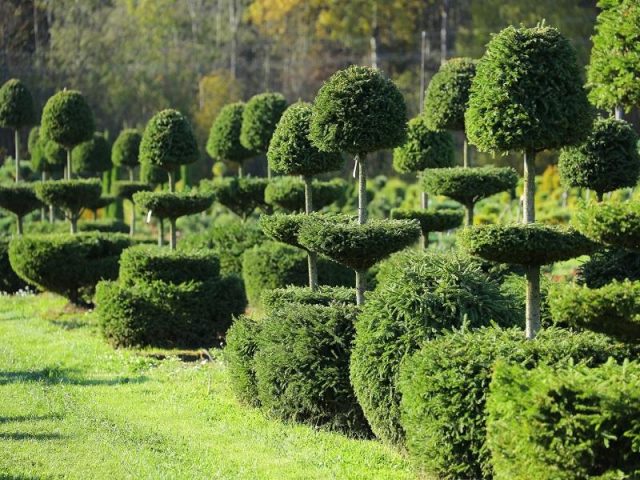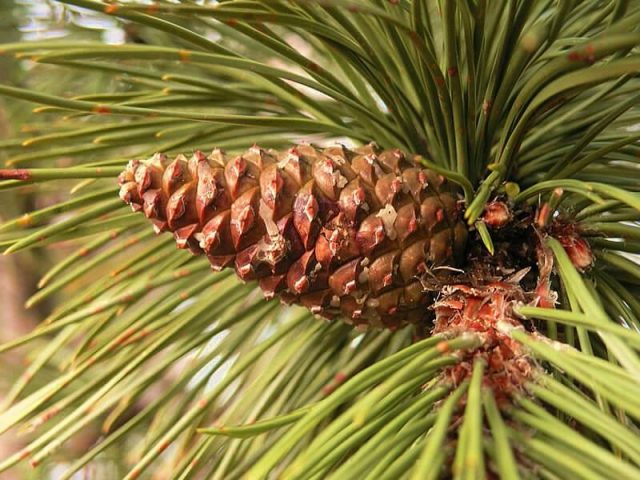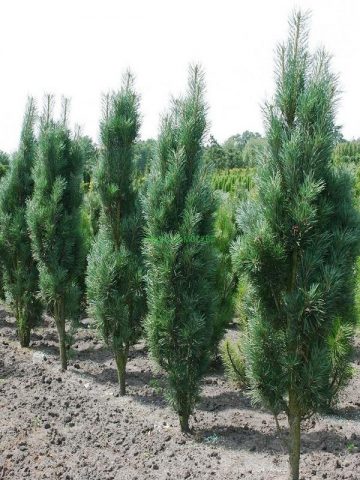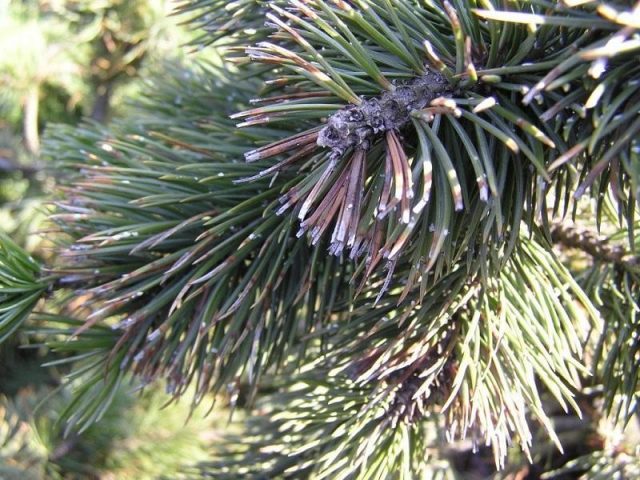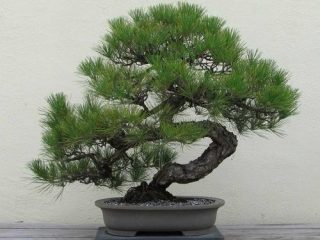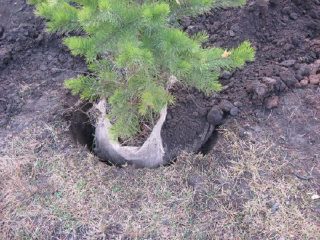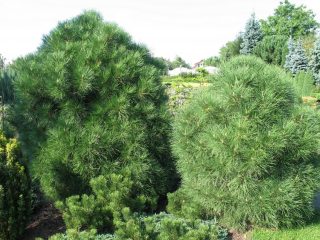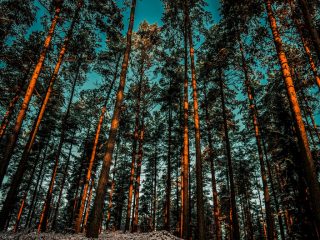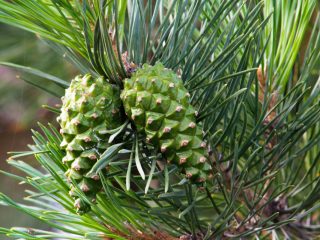Content
The design of any site, park, estate looks much more advantageous if black pine is used. The evergreen plant serves as an excellent background for other trees and shrubs, purifies the air, creating a unique microclimate around itself. There are a large number of pine varieties that differ in appearance, growth, characteristics. This variety allows you to choose a species that meets any needs of the owners, the characteristics of their site.
Description of black pine
Pine black, or Austrian - evergreen coniferous, wild tree up to 55 meters high. Its life span is 800 years. At a young age, culture has a pyramidal shape. Later, it changes, taking on the appearance of an irregularly shaped umbrella. The trunk of the plant is straight, black-gray in color, with pronounced grooves.
Young shoots are gray in color, but later darken, acquiring brown tints.
The needles of the tree are dense, bright green, shiny or dull, grows vertically. The needles are sharp, long, up to 15 cm, collected in bunches of two.
Black pine has yellow male flowers in the form of spikelets and female flowers - brownish cones.
Cones are ovoid, brown, shiny, up to 7 cm long, located horizontally on short cuttings. They ripen elongated seeds up to 6 mm in size, gray. The opening of the cones occurs in the third year.
The roots of the tree are pivotal, powerful, go to great depths.
Pine bears its name because of its dark bark and dense needles.
Where does the black pine grow
Due to its wide distribution in the mountains of Europe, black pine is also called mountain pine. The growing area covers the Mediterranean region, Morocco, Algeria. The plant prefers calcareous soils, found on open sunny slopes. The tree rises to a height of 1500 m. It does not like decomposition products of mountain magma and grows poorly on them. Easily tolerates winds and droughts. In illuminated areas, it shows good growth, forms forests.
Black pine varieties
The variety of species of black pine is so great that for any purpose you can choose a variety that successfully performs the functions of wind protection, decoration or hedge. Pines differ in crown shape, height, diameter, color, quality of needles, and other indicators.
Pine black Nana
Represents a low - up to 3 m - decorative view with a crown in the form of a ball. The growth of the culture is slow, about 5 cm per year. The bark of this ephedra is brown, with scales. The needles are hard, long, almost black. The shoots of the plant are located vertically, its roots are deep, strong.
Pine black Nana loves light, and in the shade can die. It also does not tolerate drought. In an adult state, the culture is frost-resistant, however, at a young age, in severe winters with little snow, it can freeze slightly.
Pyramidalis
The black pine of this species has a narrow pyramid-shaped crown. It grows rapidly - about 20 cm annually. The maximum height of the representatives of the Pyramidalis variety is 8 m, the crown diameter is up to 3 m. The needles are dark green, hard, collected in bunches of two needles. Against the background of the dark bark, yellowish cones stand out noticeably. The plant is undemanding to soils, it can grow on almost any soil, but it gives more preference to its calcareous composition.The tree tolerates polluted gassed air, severe frosts well, therefore it is recommended for planting in an urban environment.
Fastigiata
The ornamental black pine variety is grafted. The crown of the tree is narrow, conical, with powerful shoots. It grows slowly, at the age of 15 it reaches 2 m in height, 0.5 m in width. At 30 years old, the growth of the plant is 20 m.
The needles of the plant are straight, shiny in the form of panicles on short shoots, its cones are brown, in the form of a cone. Ephedra is not picky about soil and lighting. Looks great both in group and single landings. Gardeners call the variety "blue candles". In Eastern Europe, the black Fastigiata pine has been in demand for more than a century and a half.
Japanese
Pine of medium height - about 25 m, common in Japanese gardens. On good soils, the tree grows up to 40 m. Its shape changes with age from conical to pyramidal. Ephedra bark with scales and cracks, turns black at an older age.
Dark green, long needles, collected in bunches, are located at the ends of the branches of the plant. The Japanese black pine loves sunny places, is tolerant of drought, and has high seed germination.
The tree tolerates salty sea spray and wind, which is why it is often used to strengthen dunes.
Helga
This variety belongs to the dwarf species of black pine, with a dense conical crown. Its shoots with long, bright green needles can also have white, ornate needles.
Pine grows slowly. At 10 years old, it reaches a height of 1 m and a diameter of 1.5 m. The plant is resistant to wind, but the sun's rays can cause burns to the needles. The culture withstands rocky soil, prefers loamy soil.
Use in landscape design
More than 40 varieties of black pine provide ample opportunities for their use in creating a design for a park, alley, estate, and local area.
Compositions in which deciduous and coniferous trees, shrubs, flowers are combined with black pines of various sizes, give any space a cosiness and originality.
Dwarf forms of black pine, having a spherical and conical shape, are used to decorate alpine hills, flower beds, alleys. Low-growing varieties look advantageous against the background of stones, cereals and heather plantations.
For a small garden, pine trees with a height of no more than 4 m are suitable.
Tall plants are used both in individual and group plantings. It should be noted that in the first years they grow slowly, and reach their maximum height at 30 years old.
On a large plot, freestanding "blue candles", Japanese black pine with a bizarre crown shape look majestic. Trees can be used to delimit areas and their zones.
The use of black pine trees in landscape design has a number of advantages:
- a large selection of varieties;
- the presence of trees with different shades of needles;
- undemanding to soil and care;
- unique decorativeness.
Black pines go well with deciduous shrubs, perennial ground cover plants, primroses. The close arrangement of conifers of this species with lilacs, bird cherry birch is not welcome.
Planting and caring for black pine
Black pine is an unpretentious plant, however, to achieve a presentable look, you need to know the features of its planting:
- the area where the pine is located can be both illuminated and shaded;
- the plant is capable of developing on stony, sandy, saline soils;
- black pine grows poorly on compacted soils;
- easily tolerates air pollution;
- an adult plant has frost and drought resistance;
- in winter, branches under the weight of snow can easily break;
- the seedling hole must be at least 80 cm deep;
- the use of drainage is mandatory;
- watering a young plant should be carried out regularly;
- young seedlings need winter shelter from frost;
- feeding is carried out in the third year after planting;
- to create a beautiful dense crown, periodic pruning of shoots is necessary;
- for preventive purposes, it is worth treating black pine from diseases and pests with the help of folk remedies and chemicals.
Seedling and planting plot preparation
For painless engraftment of black pine after planting, it is necessary to carefully prepare the place and the seedling.
A sunny place, sandy and sandy loam soils are quite suitable for growing coniferous trees. In the case of heavy clay soil, high-quality drainage will be required. It is important to determine the acidity: it must be neutral or alkaline. For high pH values, lime should be used. The site intended for pine seedlings must be carefully dug up. Consideration should be given to options for protecting pine trees from direct sunlight. Shading can be created from shields, non-woven fabric.
The best planting time is early spring. Black pine can be purchased at a specialty store, nursery, or grown on your own. The second method will be more laborious and time consuming. When purchasing a finished plant, you need to pay attention to several points:
- His age must be at least five years;
- needles - uniform, bright green, elastic, shiny;
- the root system should be placed in a container and covered with moist soil;
- all parts of the plant should be examined in order to detect diseases and pests.
By purchasing a black pine sapling in the nursery, the buyer receives a guarantee of the purity of the variety and detailed advice on planting methods, the intricacies of care.
Landing rules
The seedling will need a planting pit, which is prepared before the plant is delivered. Its size should be one and a half times larger than the clod of earth with which the tree is transplanted. If a pine tree grows up to 70 cm, then a pit size of 60 by 60 cm and a depth of about 70 cm will be sufficient. For taller plants, the pit increases by another 10 cm in all respects.
If there is heavy soil on the site, sand mixed with earth is poured onto the bottom of the pit, drainage is laid on top, which can be used as expanded clay, broken brick, pebbles. If drainage is laid, then the planting hole is preliminarily deepened by another 20 - 30 cm.
It is worth preparing in advance a soil mixture consisting of sand and fertile soil, pouring it with a slide at the bottom of the planting pit, and then pouring at least two buckets of water there.
A black pine seedling in a container must be wetted abundantly and carefully freed from it. Put the plant together with an earthen lump in the center of the hole, cover all the remaining voids with soil mixture. Next, compact the soil around the trunk so that the root collar (where the trunk transitions to the roots) is at ground level. If it is too deep, rotting and death of the plant is possible. After planting, the plant should be watered from a watering can, so as not to erode the soil and mulch the trunk circle. If necessary, it is worth shading black pine, making a support to avoid damage during the wind.
Watering and feeding
When growing black pine, special attention should be paid to watering. Despite the plant's drought tolerance, there are times when it needs additional moisture. These include the time after planting or transplanting, when the seedling needs to take root, fix the roots and begin development in new conditions. Excessive dampness of the soil also harms the young plant, so watering the black pine at this time should be regular, but dosed, based on the condition of the soil.
To prepare for wintering, abundant watering of the pines in the autumn is recommended. The moist soil will give moisture to the roots, and those, in turn, to the needles, which will avoid burning it in early spring.
The rest of the time, adult plants do not need additional watering: precipitation is enough for them.The exceptions are cases of extremely high temperatures and lack of precipitation.
More than drought, the danger for black pine is excessive moisture, stagnant water in the ground, which should be avoided even during planting.
Mulching and loosening
Black pine is an unpretentious tree that does not require constant care. In the first time after planting the plant, it is regularly removed weeds and soil moisture. Subsequent shallow loosening opens up oxygen access to the root system.
Mulching the soil around the plant helps to preserve moisture and protect the tree trunk from weeds. Pine needles, crushed bark, coniferous humus are used as mulch. Do not use fresh sawdust in this capacity, as they acidify the soil and can contribute to the introduction of harmful bacteria. The mulch gradually decays and turns into fertilizer. Periodically, it is replenished to a layer of 10 - 15 cm. In preparation for winter, it is worth increasing it additionally so that the roots of a young seedling do not freeze, and the plant overwinters successfully.
Pruning
You can start forming the crown of a black pine one year after planting. In order for a tree to be healthy, it needs sanitary pruning, during which old, dry branches are removed.
Pruning allows you to shape the tree, make it more beautiful, give the desired shape to the hedge. The procedure is recommended when the plant is no more than 170 cm high. After the crown has grown, pruning is complicated due to large branches, as well as the possibility of stress in the plant, up to its death - with a large loss of green mass.
When pruning black pine, you should follow the rules:
- the procedure should be carried out at the moment of emergence of shoots, when there are "candles", but the needles have not yet blossomed on them;
- use garden shears with long, sharp, disinfected blades;
- start processing from the top of the pine, separately cutting off the skeletal branches;
- you cannot cut the shoots on the needles: in this case, the needles will turn yellow;
- the places of trimming must be treated with copper sulfate, and large cuts - with garden pitch;
- it is not recommended to remove more than a third of the green mass in one operation.
Pruning can be done for decorative purposes to create hedges. In this case, the crown retains a pyramidal or other shape, giving it greater clarity, and the plant itself - density and fluffiness.
Pruning black pine can rejuvenate the old tree. This requires:
- In order to awaken dormant buds in the autumn, cut off the ends of bare branches.
- Delete the oldest branches.
- After pruning, leave the needles on the shoots.
Such pruning of black pine is carried out no more than once every three years.
Preparing for winter
Preparing a plant for winter should start with top dressing. Already in August, it is impossible to use nitrogen fertilizers, it is better to focus on phosphorus-potassium fertilizers, so that a new growth of black pines can mature, and their roots have become stronger.
At the end of the autumn leaf fall, it is necessary to well moisten the near-stem circle of the plant to the width of the crown. This will enable the tree to successfully overwinter in any conditions.
Additional mulching with a layer of about 15 cm is another factor in successful wintering.
During snowfalls, freezing rains, branches and tops of black pine can be damaged. To avoid this, tying the pyramidal crowns of low pines is recommended in a spiral, without tightening the twine tightly.
Stones can be placed under undersized forms to prevent deformation.
Stake support will help anchor small plants.
At the end of autumn, a complex treatment of plants from pests and diseases is carried out using fungicides, insecticides, acaricides.
A winter shelter for black pine trees is built to avoid burns.Screens or shields are installed on the south side of the trees, so that when the temperature rises temporarily, the pines do not come out of their dormant state. You can use covers made of gauze or burlap, capable of letting in some of the sunlight and air. The use of polyethylene as a covering material is contraindicated, since the crown can rot under such conditions. Shelters are removed from the conifers after the soil thaws.
Reproduction
Black pine can be grown in your area by sowing seeds. It is believed that this is the most reliable method, since propagation by cuttings does not give a positive result. With the help of grafting, it is possible to breed some types of black pine, but there is no 100% guarantee.
To grow a seedling on your own, you must:
- In autumn, collect black pine cones, dry them, remove the seeds.
- Sowing is carried out in the fall in open ground or in the spring - in boxes.
- Before sowing, the seeds should be stratified - by keeping at a low temperature of the refrigerator for two months.
- Prepare boxes, pots, containers with drainage holes in the bottom.
- Fill containers with fertile soil, sprinkle with peat on top.
- Spread black pine seeds on the surface at a distance of 5 mm from each other, without deepening them, sprinkle a little with soil.
- Water in moderation.
- Maintain a temperature around 20 oFROM.
- Transplant into open ground should be carried out only next spring.
Black pine pests and diseases
Diseases affect black pines due to environmental pollution, the appearance of a source of infection, pests. Viruses and fungi most often accumulate in litter. The litter of needles contains a lot of bacteria that cause plant diseases:
- rust - when mushrooms infect needles, bark, and easily move from conifers to other trees;
- rust cancer, which infects young pine shoots, and after a few years they form orange bubbles filled with a large number of spores;
- pine twirl, in which the shoots bend, and the top dies off;
- scleroderriosis, making the needles brown, sagging, falling asleep and crumbling;
- bark necrosis - when the tops of the shoots die off, starting from the top, while the needles turn red, dry out, may not fall off for a long time;
- shyute - a fungal disease in which the needles change color and die off; the affected plant most often dies.
For the prevention and treatment of diseases of black pine, planting material should be carefully selected, plants should be thinned out in time, sprayed with fungicidal solutions, and sanitary pruning should be carried out in a timely manner.
Black pine has many pests:
- Hermes;
- sub-bed bug;
- aphid;
- shield;
- spider mite;
- pine scoop.
For pest control, special preparations are used: Decis, Aktara, Engio, Confidor, Mospilan and others.
Conclusion
Black pine not only has an attractive appearance, but is also an inexhaustible natural source of bioactive substances. She has so many varieties that it is not difficult to find a plant with certain parameters. Dwarf forms and large trees of this species will definitely take their place in personal plots, parks and squares. With proper care, the pine does not get sick, it develops well and will delight more than one generation with its appearance.
